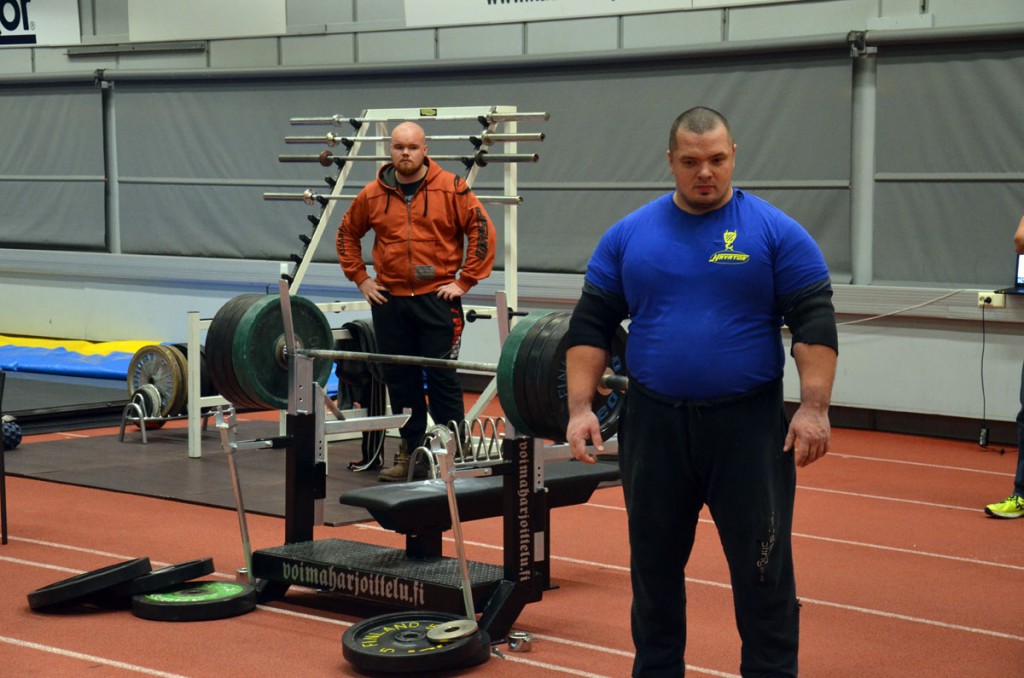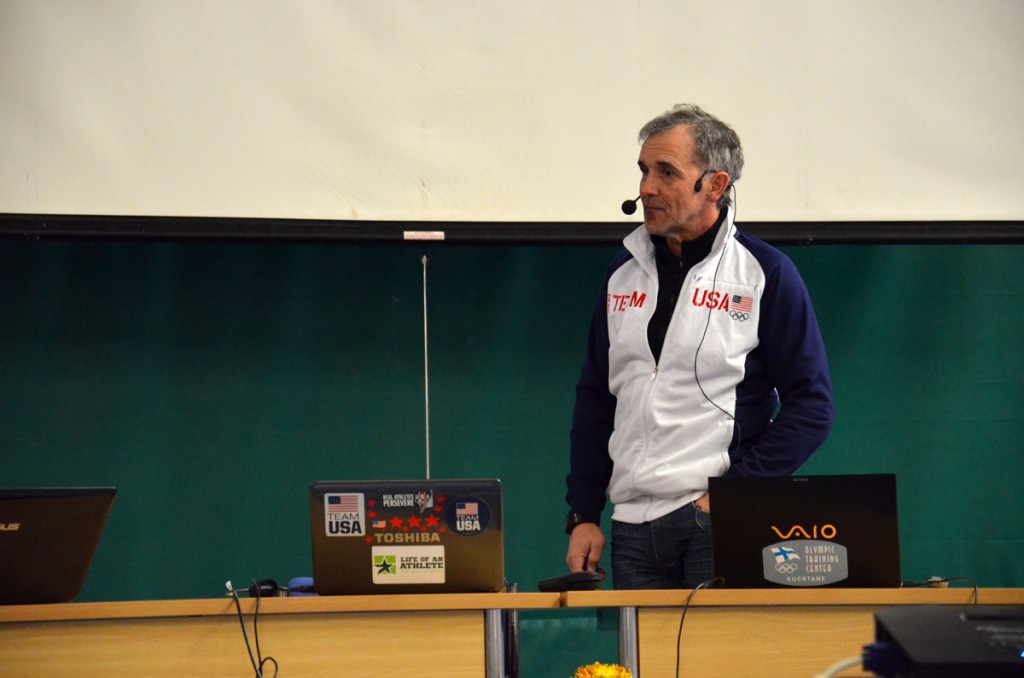Osallistuin Kuortaneen urheiluopistolla Voimavalmennusseminaariin, joka oli järjestyksessään peräti jo kolmaskymmenes! Alla on hieman siistittyjä muistiinpanoja luennoilta. Jokaisen luennon lopussa on lyhyesti muutamalla kohtaa, että mitä esityksestä jäi päällimmäisenä mieleen.
Kaikki esiintyjät ja ohjelman löydät täältä. Osa muistiinpanoista on suomeksi ja osa englanniksi. Koittakaa kestää. Jos nämä ovat kiinnostavia, niin laitan jälkimmäisenkin osan myöhemmin esille.
John Underwood – CNS fatigue
Jos urheilijalla on paljon ailahtelevia suorituksia, niin syytä on hyvä etsiä hermostosta, tai tarkemmin sen väsymystilasta.
3000m juoksuaika huononi 15s, kun sitä edelsi 90min kestoinen vaativa mentaalinen testi.
NL:ssä käytettiin jo 1940-1980-luvulla CNS:n tilan testausa visuaalisella reaktiotestillä, otevoimalla, vertikaalihypyllä, ”silmien räpsytysfrekvenssillä”, ”brain games” ja lyijykynällä mahdollisimman monen pisteen tekeminen 5s aikana. Underwood käyttää CNS Tap Test –mobiiliapplikaatiota yliopistotason urheilijoilla.
CNS Tap Testin suoritus: puhelin pöydällä, kolme sormea ja peukalo pöydällä ja etusormella naputuksia. 60-70 kertaa tyypillinen tulos levänneenä! Aivojen yhteys käsille on lyhin ja nopein mahdollinen hermorata, eli se toimii hyvänä mittarina.
Keskushermoston tarvitsee eri asioita palautumiseen kuin muu keho tai erityisesti lihakset.
”If you´re going to train very hard. Of course you need to rest very hard.” –Keijo Häkkinen
Tekijät, jotka verottavat aivojen energiatasoa:
- Unen puute! Verenkierto esimerkiksi ajattelun ja tasapainon alueella aivoissa on valvomisen jälkeen selvästi pienempi. Tämän vuoksi huono tasapaino ja ”sumuinen ajattelu” on tyypillistä pitkän valvomisen jälkeen.
- Raskas ajatustyö ”väsyttää” aivoja.
- Nykyteknologia. Kaikki ”vimpaimet” lisäävät ajatustyötä pitkin päivää. Esimerkiksi kirjaa lukiessa aivojen kapasiteetista on käytössä vain puolet verrattuna esimerkiksi internetin selaamiseen.
Parhaita keinoja CNS:n palautumisen edistämiseen:
- Uni!
- Aivojen palautumista edistetään jo nyt matalatehoisilla sähköimpulseilla (1-2 ampeeria) erityisiä laitteita käyttäen – aivan kuten lihaksia. Kun aivoihin johdetaan sopiva määrä sähköä, niin aivoissa erityy BDNF nimistä ainetta (Brain-derived neurotrophic factor). Maarten Frens on kovan luokan hollantilainen aivospesialisti. Asiasta löytyy TED-puhe.
Määritelmä CNS:n väsymiselle: ”Neural fatigue (NF) is defined as an involuntary reduction in voluntary actions. ”
Jos kilpailu on lauantaina, niin hermostollisesti vaativat harjoitukset ja muut kuormitukset olisi hyvä jättää pois jo keskiviikosta lähtien. Tämä on luonnollisesti kuitenkin laji- ja urheilijasidonnaista.
Jonathan Leeder – Principles of the Transfer from power training to bike specific speed
Why is Power important?
- Velocity determnies performance
- Velocity doesn´t represent physiological demand
- Aerodynamics/gradient
- Only power tells us the true physical demands
How fast is fast enough to win Olympic gold? Back calculate power and cadence determinants. In simple terms – work backwards!!
Philosphy (it took about one year to work this out in an Olympic cycle)
- Event demands (determinants model, historical model, proactive model, event specific)
- Profile athlete against event (Linked to event demands. 1) Performance history. 2) Gap analysis)
- Objectives and goal setting (Linked to event demands and athlete profiling. Measurable targets. Also includes 1) Risks and limiting factors. 2) Gap intervention. 3) Special projects) (Coach driven / athlete centered. Will incorporate ST and LT goals)
- Develop performance plan (Coach driven / athlete centered)
- Monitor and audit. (Validate KITs. Individualized KPIs)
When the program is coach driven / athlete centered, the athlete has a profound effect how the program is designed and executed. When he or she enters the race there is no reason to not to perform well.
Power measurement
- Power = force x velocity
- Specific to cycling = torque x cadence !
Mathematical modelling
- Cycling speed is equilibrium of propulsive power and resistive forces
- Propulsive power: Crank power
- Resistive forces: Inertia (mass), aerodynamics, rolling resistance, drivetrain effiency.
Determinants of Maximal power
- Muscle mechanics (force-velocity relationship, force length, contraction type. The force-velocity relationship one is the one we can effect most!)
- Muscle morphology (Cross section area, pennation angle, muscle length, fibre type (can´t be really effected! Therefore it´s not measured!), motor tendon unit stiffness). If CSA would be the most important factor then weightlifters etc. would do well in the track. For example Robert Forstmann who has BIG legs but not the fastest time. So CSA is important but not the most determining factor.
- Neural factors. (Motor unit recruitment, firing frequency, motor unit sycnhronization, inter-muscular coordination). It´s important to have big and strong muscles, but it´s at least as important to be able to turn them on fast enough and with optimal coordination and synchronization!
- Muscle environment (Fatigue, temperature, potentriation, hormonal status). This is important on race day. For example to keep the temperature right we have even developed special trousers to keep legs warm before race. Quite similar to covers they use in the tires in Formula 1. Possible potentiation is done usually used about 8min before a race!
Training
- Training for force – slow / CSA / pennation
- Training for velocity – fast / CSA / pennation. These two factors have some
- Periodisation
- Specific muscle coordination patterns
- This must be planned and executed very carefully since force and velocity can be opposing qualities.
- It is very important to monitor that force will transfer to all speeds. It can be seen as a higher power output in all cadences.
Determinants in Track cycling in the 1st lap:
- Gym strength, CSA
- Start technique
- Bike specific strength
- Muscle characteristics
Periodisation!
- Need for high force at low cadence to accelerate mass at start
- Meed for high maximal power to accelerate and generate speed
- Need for max speed to win
- Need to hold onto speed once fast enough
We don´t believe that you need ANY endurance or long duration training (road rides etc.) before you´re fast enough!
Conclusions
- Speed is relationship between propulsive froces and resistive forces – Understand tand focus on both!
- Power is determined by the volume of muslce activated – therefore you need big CSA and able to coordinate it. In other words gym & bike!
- Protect phases. Sprint training is all about high quality, not quality. ”If the speed or power isn´t high enough we send the athlete to home to rest and recover.”
- Whole process requires meticulous planning and high level of monitoring.
Fredrik Smulte – Penkkipunnerruksen harjoitusdemo
Jos herra ei ole tuttu, niin kannattaa lukea Lihastohtori Hulmin mainio haastattelu hänestä. Ensinnäkin on sanottava, että Fredrik on vaatimaton, mutta samalla äärimmäisen hyvä showmies, joka tiesi asiansa. Näytös oli hauska ja samalla myös opettava. Ja onhan mielenkiintoista nähdä, kuinka 287,5 kg nousee ilman varusteita!
Fredrik uskoo, että kehitys tapahtuu kolmen eri tekijän kautta:
- Tekniikka
- Riittävä ravinto
- Määrän/volyymin lisääminen ajan myötä!
Fredrik on treenannut 17 vuotta. Suurin osa treenitiedosta on itse opittua. Monia harjoitustyylejä on tietenkin kokeiltu matkan varrella.
Fredrik treenaa 5 kertaa viikossa. Jokaisella harjoituskerralla penkissä tulee sarjoja 15-20 kappaletta(!) Työsarjoiksi hän laskee vain yli 70% intensiteetillä tehdyt sarjat. Tyypillinen sarjapituus on 2-3 toistoa. Peruskuntokaudella ja noususarjoissa tehdään pidempiä sarjoja.
Ennen treenatessaan neljä kertaa viikossa sarjoja penkissä tuli 20-25 kappaletta. Tämä venytti harjoituksen kestoa usein liikaa.
Tyypillinen harjoituskerta kestää noin kolme tuntia. Ensimmäinen puolikas menee pelkästään penkkiin. Loppu ajasta menee apuliikkeille.
Kyykkyä ja alavartalopainotteisia liikkeitä Fredrik tekee kahdesti viikossa. Tämän hän ajattelee lähinnä penkkiä tukevana harjoitteluna.
Fredrik vannoo vastuskuminauhojen käytön hyötyyn harjoittelussa.
Fredrikin penkkitekniikka on epätavallinen, sillä jalat ovat totuttua leveämmällä. Hän painottaa lapojen yhdessä pitämisen tärkeyttä. Tämä säästää olkapäitä ja mahdollistaa vahvemman asennon.
Helsingin sanomat oli laskenut, että Fredrik on tehnyt tähän mennessä noin 900 000 toistoa! Hyvään tekniikkaan tarvitaan arviolta noin 10 000 toistoa, Fredrikillä on siis 90-kertainen määrä tähän nähden.
Fredrikin mielestä täytyy voittaa neljä asiaa: youtube, punnitus, kisa ja kisojen jatkot.
Lopuksi Fredrik sanoo tavoitteista kysyttäessä, että menee vuosi kerrallaan. Hän haluaa olla paras penkissä IPF:n (WADA:n testaama) kisoissa. Lisäksi hän sanoo, että 70kg ylipaino ei ole pitkällä aikavälillä terveellistä. Tällä hetkellä paino on 150kg.
” Jos vielä yötöistä pääsisi eroon, niin tästä voisi vielä tulla jotain. Noh, kaikkea ei voi saada…”
John Underwood – Supercompensation
The biggest factor we can influence is recovery! We already know pretty well the training side of the equation. The biggest secrests lie on the other side.
Muscles have been studied for about 50 years. It´s time to look from other places. Underwood himself has studied this area himself for 35 years.
The hardest concept for high achievers is to understand the importance of recovery!
Most elite level athletes are used to feeling tired almost all the time.
In a group of athletes there´s a big variety in recovery. Some might be well recovered and some not. It can also vary from day to day within one athlete. Everyone is different!
The challenge of training
- The same signals that lead towards an overtraining response are what stimulate the organism to improve in the first place.
- Using recovery/restorative measures can potentially negate some of the stimulusu for improved fitness
Do not blunt inflammatory response! A big study was made named Oregon running project. If blunting the inflammatory response happens all the time it also erases the stimulus for supercompensation and development.
Inflammatory response happens normally during the night. Do not use NSAID´s etc before bedtime.
NSAID´s aren´t used anymore! Not at least after the game. If for some reason those are used we use them only during morning and daytime because it fits better into the body´s hormonal environment.
No ice here please! Cold treatment blunts the inflammatory response and therefore even the training effect. Localized icing is still beneficial for injured areas etc.
Japanese have most likely the most developed sport science in the world. Funny thing that it´s all secret. Prerry much like it was 20 years ago in the Eastern block.
How much training is enough? Optimal stimulation with minimal damage.
Because of hormonal environment (testosterone etc) it´s most beneficial to do the training in the first part of the day before hormone levels decline. Of course provided that the athlete is rested.
When thinking about hormonnal environment it´s the best to do the most important and heaviest work 35-50min after the start of the workout.
The biggest HGH (human growth hormone) response happens about 120min after falling asleep.
4 levels of fatigue
- Metabolic
- Structural
- Endocrine
- Neuro-muscular – Requires the longest to recover!
In 60 minutes body can recover about 70%! The following 20% will happen in 8 hours and the rest 10% usually in 24 hours. The order of importance when it comes recovery modalties after training:
- 1 hour – nutrients
- 8 hours – sleep, rest and therefore HGH
If you dont´get to 70% recovered in one hour the whole recovery process might end up incomplete!
The most important thing during the one hour period is to get protein in the system. For example 40g of protein and 60-70g of carbs. Number one is whey and/or BCAA´s.
The highest rates of nutrient uptake occure about 10min after the training session! 20-30min is often times too late.
Protein is the number one thing to get into your system after a resistance training session. The quicker the better, so do provide the needed nutrients!
Bedtime should be the same every day. If the time of going to bed varies a lot body is out of rhythm and HGH release is blunted.
When reading a book brain has the half of the activation when compared to browsing the internet!


Vastaa